 | ÐлекÑÑоннÑй компоненÑ: AD8131 | СкаÑаÑÑ:  PDF PDF  ZIP ZIP |
Äîêóìåíòàöèÿ è îïèñàíèÿ www.docs.chipfind.ru
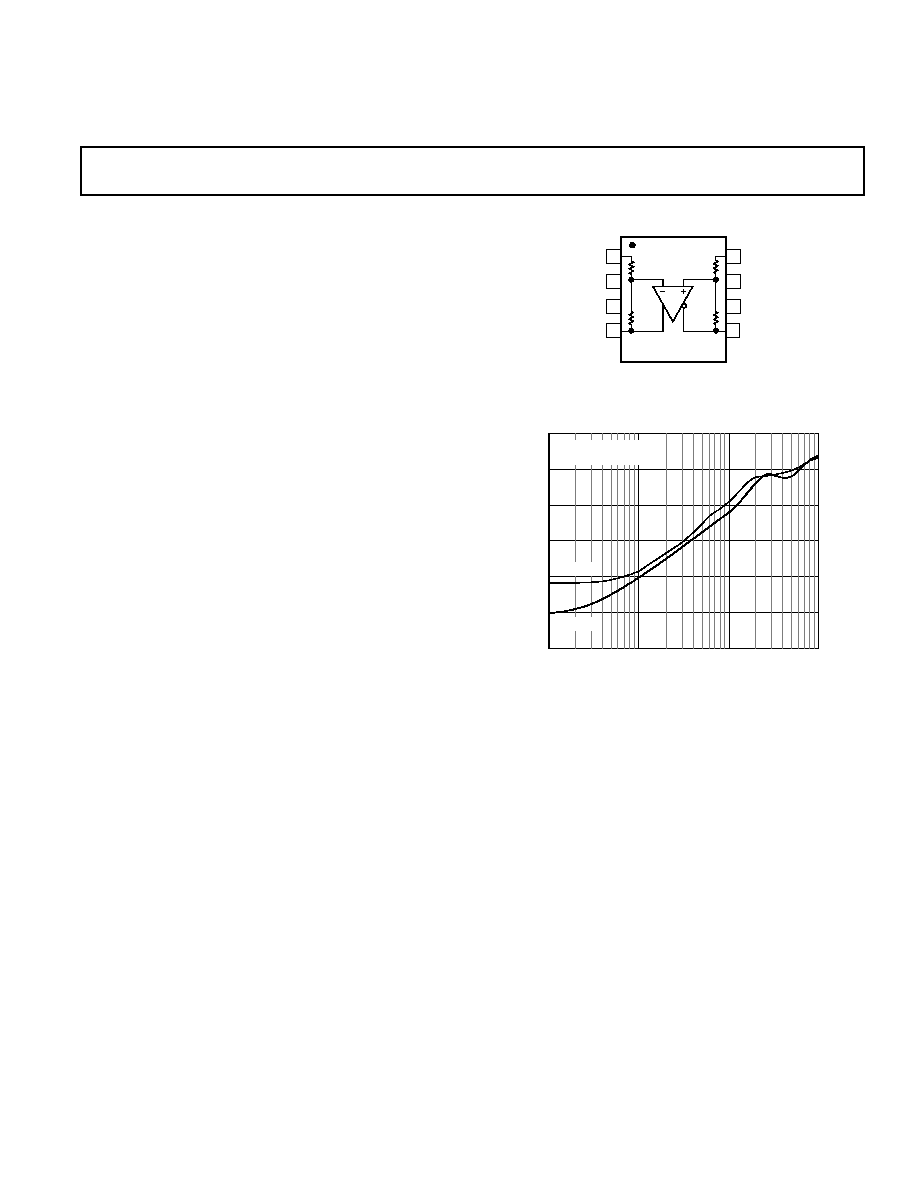
REV. 0
Information furnished by Analog Devices is believed to be accurate and
reliable. However, no responsibility is assumed by Analog Devices for its
use, nor for any infringements of patents or other rights of third parties
which may result from its use. No license is granted by implication or
otherwise under any patent or patent rights of Analog Devices.
a
AD8131
One Technology Way, P.O. Box 9106, Norwood, MA 02062-9106, U.S.A.
Tel: 781/329-4700
World Wide Web Site: http://www.analog.com
Fax: 781/326-8703
© Analog Devices, Inc., 1999
Low-Cost, High-Speed
Differential Driver
FUNCTIONAL BLOCK DIAGRAM
1
8 +D
IN
D
IN
2
7
NC
V
OCM
3
6
V+
V
4
5
OUT
+OUT
AD8131
NC = NO CONNECT
1.5k
1.5k
750
750
FEATURES
High Speed
400 MHz 3 dB Full Power Bandwidth
2000 V/ s Slew Rate
Fixed Gain of 2 with No External Components
Internal Common-Mode Feedback to Improve Gain
and Phase Balance
60 dB @10 MHz
Separate Input to Set the Common-Mode Output
Voltage
Low Distortion
68 dB SFDR @ 5 MHz 200
Load
Low Power 7.5 mA @ 3 V
Power Supply Range +2.7 V to 5 V
APPLICATIONS
Video Line Driver
Digital Line Driver
Low Power Differential ADC Driver
Differential In/Out Level Shifting
Single-Ended Input to Differential Output Driver
GENERAL DESCRIPTION
The AD8131 is a differential or single-ended input to differen-
tial output driver requiring no external components for a fixed
gain of 2. The AD8131 is a major advancement over op amps
for driving signals over long lines or for driving differential input
ADCs. The AD8131 has a unique internal feedback feature that
provides output gain and phase matching that are balanced to
60 dB at 10 MHz, reducing radiated EMI and suppressing
harmonics. Manufactured on ADI's next generation XFCB
bipolar process, the AD8131 has a 3 dB bandwidth of 400 MHz
and delivers a differential signal with very low harmonic distortion.
The AD8131 is a differential driver for the transmission of
high-speed signals over low-cost twisted pair or coax cables.
The AD8131 can be used for either analog or digital video
signals or for other high-speed data transmission. The AD8131
driver is capable of driving either Cat3 or Cat5 twisted pair or coax
with minimal line attenuation. The AD8131 has considerable
cost and performance improvements over discrete line driver
solutions.
The AD8131 can replace transformers in a variety of applica-
tions preserving low frequency and dc information. The AD8131
does not have the susceptibility to magnetic interference and
hysteresis of transformers, while being smaller in size, easier
to work with, and has the high reliability associated with ICs.
The AD8131's differential output also helps balance the input
for differential ADCs, optimizing the distortion performance of
the ADCs. The common-mode level of the differential output
is adjustable by a voltage on the V
OCM
pin, easily level-shifting
the input signals for driving single supply ADCs with dual supply
signals. Fast overload recovery preserves sampling accuracy.
The AD8131 will be available in both SOIC and
µ
SOIC packages
for operation over 40 C to +85 C.
FREQUENCY MHz
BALANCE ERROR dB
80
1
1000
40
10
100
20
30
50
60
70
V
OUT
,dm = 2V p-p
V
OUT
,cm/ V
OUT
, dm
V
S
= +5V
V
S
= 5V
Figure 1. Output Balance Error vs. Frequency
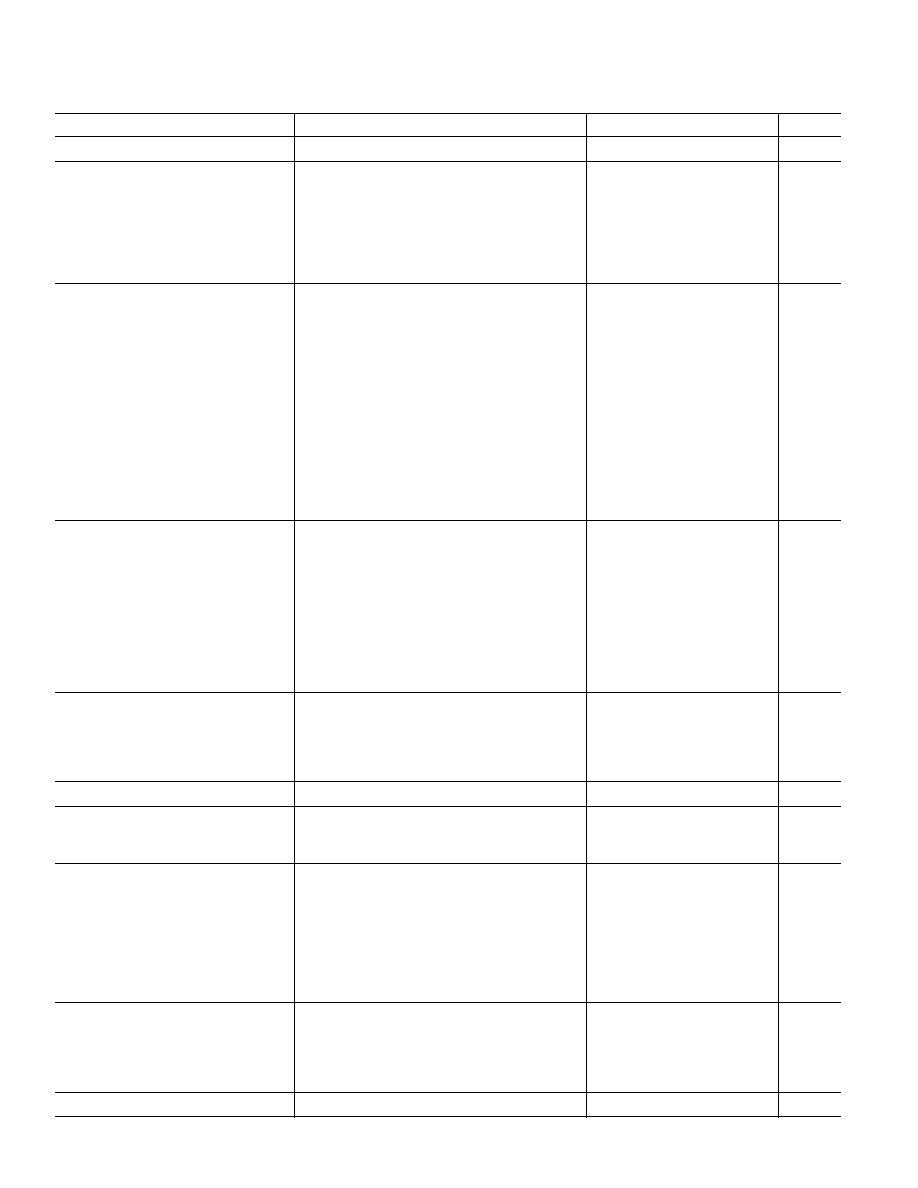
REV. 0
2
AD8131SPECIFICATIONS
Parameter
Conditions
Min
Typ
Max
Unit
D
IN
to OUT Specifications
DYNAMIC PERFORMANCE
3 dB Large Signal Bandwidth
V
OUT
= 2 V p-p
400
MHz
3 dB Small Signal Bandwidth
V
OUT
= 0.2 V p-p
320
MHz
Bandwidth for 0.1 dB Flatness
V
OUT
= 0.2 V p-p
85
MHz
Slew Rate
V
OUT
= 2 V p-p, 10% to 90%
2000
V/
µ
s
Settling Time
0.1%, V
OUT
= 2 V p-p
14
ns
Overdrive Recovery Time
V
IN
= 5 V to 0 V Step
5
ns
NOISE/HARMONIC PERFORMANCE
Second Harmonic
V
OUT
= 2 V p-p, 5 MHz, R
L,dm
= 200
68
dBc
V
OUT
= 2 V p-p, 20 MHz, R
L,dm
= 200
63
dBc
V
OUT
= 2 V p-p, 5 MHz, R
L,dm
= 800
95
dBc
V
OUT
= 2 V p-p, 20 MHz, R
L,dm
= 800
79
dBc
Third Harmonic
V
OUT
= 2 V p-p, 5 MHz, R
L,dm
= 200
94
dBc
V
OUT
= 2 V p-p, 20 MHz, R
L,dm
= 200
70
dBc
V
OUT
= 2 V p-p, 5 MHz, R
L,dm
= 800
101
dBc
V
OUT
= 2 V p-p, 20 MHz, R
L,dm
= 800
77
dBc
IMD
20 MHz, R
L,dm
= 800
54
dBc
IP3
20 MHz, R
L,dm
= 800
30
dBm
Voltage Noise (RTO)
f = 20 MHz
25
nV/
Hz
Differential Gain Error
NTSC, R
L,dm
= 150
0.01
%
Differential Phase Error
NTSC, R
L,dm
= 150
0.06
Degrees
INPUT CHARACTERISTICS
Offset Voltage
V
OS,dm
= V
OUT,dm
; V
DIN+
= V
DIN
= V
OCM
= 0 V
±
2
±
7
mV
T
MIN
to T
MAX
Variation
±
8
µ
V/
°
C
V
OCM
= Float
±
4
mV
T
MIN
to T
MAX
Variation
±
10
µ
V/
°
C
Input Resistance
Single-Ended Input
1.125
k
Differential Input
1.5
k
Input Capacitance
1
pF
Input Common-Mode Voltage
7.0 to +5.0
V
CMRR
V
OUT,dm
/
V
IN,cm
;
V
IN,cm
=
±
0.5 V
70
dB
OUTPUT CHARACTERISTICS
Output Voltage Swing
Maximum
V
OUT
; Single-Ended Output
3.6 to +3.6
V
Linear Output Current
60
mA
Gain
V
OUT,dm
/
V
IN,dm
;
V
IN,dm
=
±
0.5 V
1.97
2
2.03
V/V
Output Balance Error
V
OUT,cm
/
V
OUT,dm
;
V
OUT,dm
= 1 V
70
dB
V
OCM
to OUT Specifications
DYNAMIC PERFORMANCE
3 dB Bandwidth
V
OCM
= 600 mV
210
MHz
Slew Rate
V
OCM
= 1 V to +1 V
500
V/
µ
s
DC PERFORMANCE
Input Voltage Range
±
3.6
V
Input Resistance
120
k
Input Offset Voltage
V
OS,cm
= V
OUT,cm
; V
DIN+
= V
DIN
= V
OCM
= 0 V
±
1.5
±
7
mV
V
OCM
= Float
±
2.5
mV
Input Bias Current
0.5
µ
A
V
OCM
CMRR
[
V
OUT,dm
/
V
OCM
];
V
OCM
=
±
0.5 V
60
dB
Gain
V
OUT,cm
/
V
OCM
;
V
OCM
=
±
1 V
0.988
1
1.012
V/V
POWER SUPPLY
Operating Range
±
1.4
±
5.5
V
Quiescent Current
V
DIN+
= V
DIN
= V
OCM
= 0 V
10.5
11.5
12.5
mA
T
MIN
to T
MAX
Variation
25
µ
A/
°
C
Power Supply Rejection Ratio
V
OUT,dm
/
V
S
;
V
S
=
±
1 V
70
56
dB
OPERATING TEMPERATURE RANGE
40
+85
°
C
Specifications subject to change without notice.
(@ 25 C, V
S
= 5 V, V
OCM
= 0, G = 2, R
L,dm
= 200
, unless otherwise noted. Refer to
Figures 2 and 37 for test setup and label descriptions. All specifications refer to single-ended input and differential outputs unless noted.)
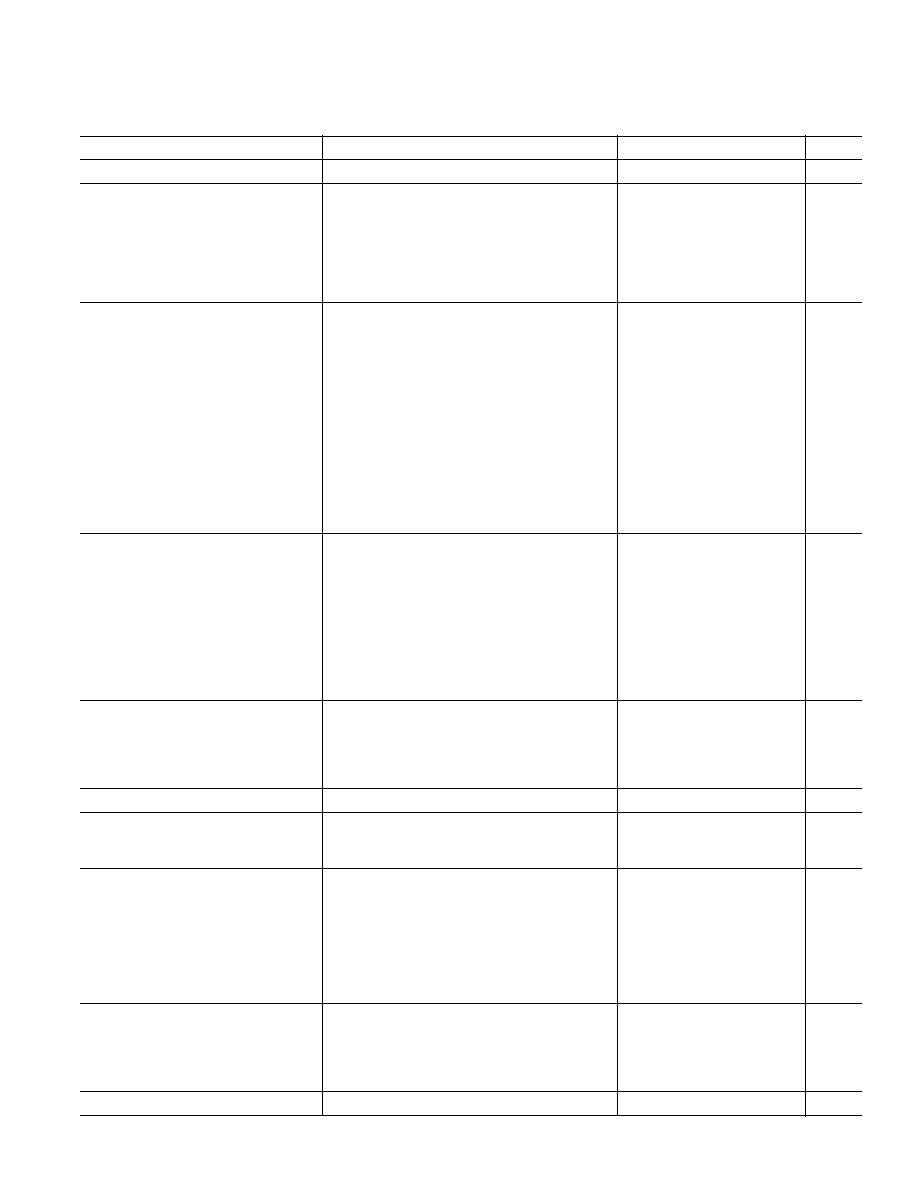
REV. 0
3
AD8131
SPECIFICATIONS
Parameter
Conditions
Min
Typ
Max
Unit
D
IN
to OUT Specifications
DYNAMIC PERFORMANCE
3 dB Large Signal Bandwidth
V
OUT
= 2 V p-p
385
MHz
3 dB Small Signal Bandwidth
V
OUT
= 0.2 V p-p
285
MHz
Bandwidth for 0.1 dB Flatness
V
OUT
= 0.2 V p-p
65
MHz
Slew Rate
V
OUT
= 2 V p-p, 10% to 90%
1600
V/
µ
s
Settling Time
0.1%, V
OUT
= 2 V p-p
18
ns
Overdrive Recovery Time
V
IN
= 5 V to 0 V Step
5
ns
NOISE/HARMONIC PERFORMANCE
Second Harmonic
V
OUT
= 2 V p-p, 5 MHz, R
L,dm
= 200
67
dBc
V
OUT
= 2 V p-p, 20 MHz, R
L,dm
= 200
56
dBc
V
OUT
= 2 V p-p, 5 MHz, R
L,dm
= 800
94
dBc
V
OUT
= 2 V p-p, 20 MHz, R
L,dm
= 800
77
dBc
Third Harmonic
V
OUT
= 2 V p-p, 5 MHz, R
L,dm
= 200
74
dBc
V
OUT
= 2 V p-p, 20 MHz, R
L,dm
= 200
67
dBc
V
OUT
= 2 V p-p, 5 MHz, R
L,dm
= 800
95
dBc
V
OUT
= 2 V p-p, 20 MHz, R
L,dm
= 800
74
dBc
IMD
20 MHz, R
L,dm
= 800
51
dBc
IP3
20 MHz, R
L,dm
= 800
29
dBm
Voltage Noise (RTO)
f = 20 MHz
25
nV/
Hz
Differential Gain Error
NTSC, R
L,dm
= 150
0.02
%
Differential Phase Error
NTSC, R
L,dm
= 150
0.08
Degrees
INPUT CHARACTERISTICS
Offset Voltage
V
OS,dm
= V
OUT,dm
; V
DIN+
= V
DIN
= V
OCM
= 2.5 V
±
3
±
7
mV
T
MIN
to T
MAX
Variation
±
8
µ
V/
°
C
V
OCM
= Float
±
4
mV
T
MIN
to T
MAX
Variation
±
10
µ
V/
°
C
Input Resistance
Single-Ended Input
1.125
k
Differential Input
1.5
k
Input Capacitance
1
pF
Input Common-Mode Voltage
1.0 to +4.0
V
CMRR
V
OUT,dm
/
V
IN,cm
;
V
IN,cm
=
±
0.5 V
70
dB
OUTPUT CHARACTERISTICS
Output Voltage Swing
Maximum
V
OUT
; Single-Ended Output
1.0 to 3.7
V
Linear Output Current
45
mA
Gain
V
OUT,dm
/
V
IN,dm
;
V
IN,dm
=
±
0.5 V
1.96
2
2.04
V/V
Output Balance Error
V
OUT,cm
/
V
OUT,dm
;
V
OUT,dm
= 1 V
62
dB
V
OCM
to OUT Specifications
DYNAMIC PERFORMANCE
3 dB Bandwidth
V
OCM
= 600 mV
200
MHz
Slew Rate
V
OCM
= 1.5 V to 3.5 V
450
V/
µ
s
DC PERFORMANCE
Input Voltage Range
1.0 to 3.7
V
Input Resistance
30
k
Input Offset Voltage
V
OS,cm
= V
OUT,cm
; V
DIN+
= V
DIN
= V
OCM
= 2.5 V
±
5
±
12
mV
V
OCM
= Float
±
10
mV
Input Bias Current
0.5
µ
A
V
OCM
CMRR
[
V
OUT,dm
/
V
OCM
];
V
OCM
= 2.5 V
±
0.5 V
60
dB
Gain
V
OUT,cm
/
V
OCM
;
V
OCM
= 2.5 V
±
1 V
0.985
1
1.015
V/V
POWER SUPPLY
Operating Range
2.7
11
V
Quiescent Current
V
DIN+
= V
DIN
= V
OCM
= 2.5 V
9.25
10.25
11.25
mA
T
MIN
to T
MAX
Variation
20
µ
A/
°
C
Power Supply Rejection Ratio
V
OUT,dm
/
V
S
;
V
S
=
±
0.5 V
70
56
dB
OPERATING TEMPERATURE RANGE
40
+85
°
C
Specifications subject to change without notice.
(@ 25 C, V
S
= 5 V, V
OCM
= 2.5 V, G = 2, R
L,dm
= 200 , unless otherwise noted. Refer to Figures 2 and 37
for test setup and label descriptions. All specifications refer to single-ended input and differential outputs unless noted.)
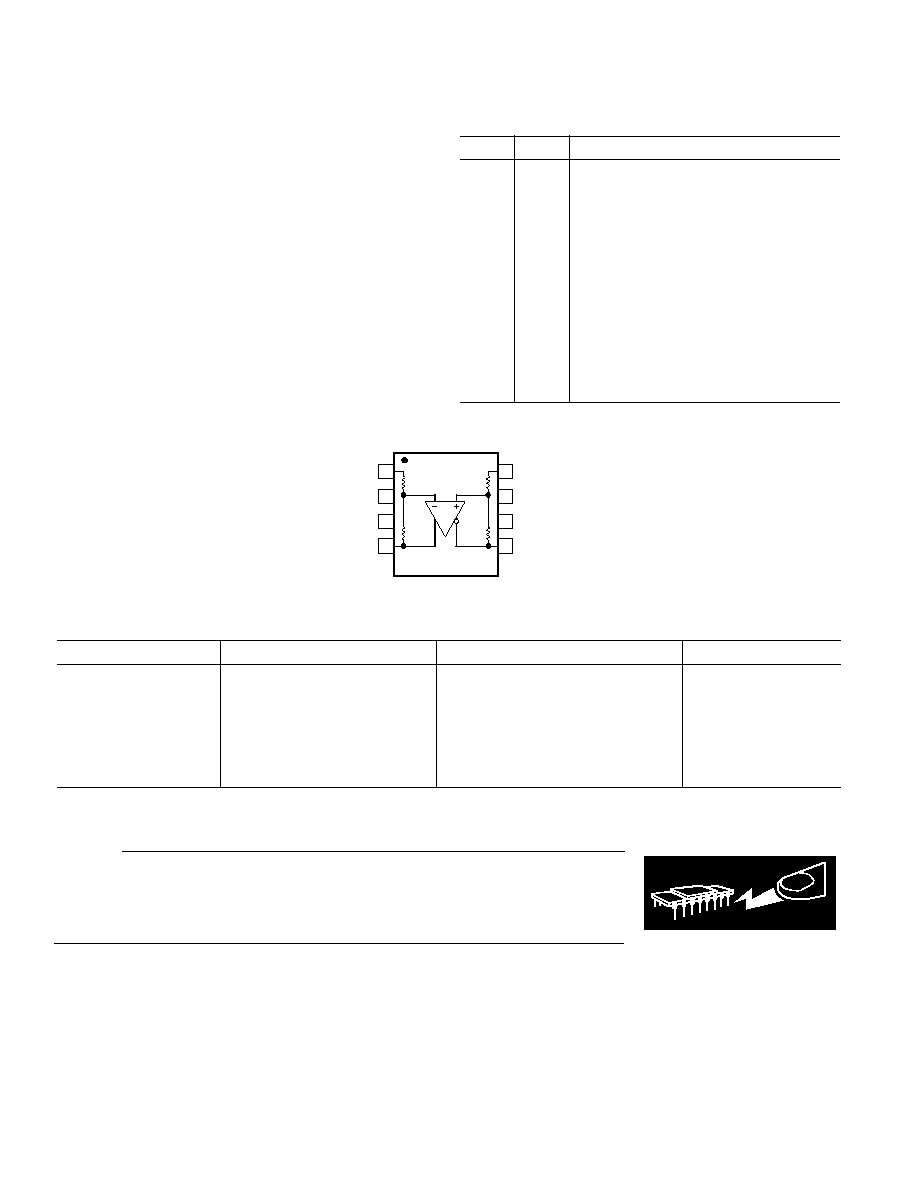
REV. 0
AD8131
4
CAUTION
ESD (electrostatic discharge) sensitive device. Electrostatic charges as high as 4000 V readily
accumulate on the human body and test equipment and can discharge without detection.
Although the AD8131 features proprietary ESD protection circuitry, permanent damage may
occur on devices subjected to high energy electrostatic discharges. Therefore, proper ESD
precautions are recommended to avoid performance degradation or loss of functionality.
WARNING!
ESD SENSITIVE DEVICE
ABSOLUTE MAXIMUM RATINGS
1
Supply Voltage . . . . . . . . . . . . . . . . . . . . . . . . . . . . . . .
±
5.5 V
V
OCM
. . . . . . . . . . . . . . . . . . . . . . . . . . . . . . . . . . . . . . . .
±
V
S
Internal Power Dissipation
2
. . . . . . . . . . . . . . . . . . . . 250 mW
Operating Temperature Range . . . . . . . . . . . 40
°
C to +85
°
C
Storage Temperature Range . . . . . . . . . . . . 65
°
C to +150
°
C
Lead Temperature (Soldering 10 sec) . . . . . . . . . . . . . . 300
°
C
NOTES
1
Stresses above those listed under Absolute Maximum Ratings may cause perma-
nent damage to the device. This is a stress rating only, functional operation of the
device at these or any other conditions above listed in the operational section of this
specification is not implied. Exposure to Absolute Maximum Ratings for any
extended periods may affect device reliability.
2
Thermal resistance measured on SEMI standard 4-layer board.
8-Lead SOIC
JA
= 121
°
C/W
8-Lead
µ
SOIC
JA
= 142
°
C/W
ORDERING GUIDE
Model
Temperature Range
Package Description
Package Option
AD8131AR
40
°
C to +85
°
C
8-Lead SOIC
SO-8
AD8131AR-REEL
AD8131AR-REEL7
AD8131ARM
40
°
C to +85
°
C
8-Lead
µ
SOIC
RM-8
AD8131ARM-REEL
AD8131ARM-REEL7
AD8131-EVAL
Evaluation Board
PIN FUNCTION DESCRIPTIONS
Pin No.
Name
Function
1
D
IN
Negative Input.
2
V
OCM
Voltage applied to this pin sets the common-
mode output voltage with a ratio of 1:1. For
example, 1 V dc on V
OCM
will set the dc bias
level on +OUT and OUT to 1 V.
3
V+
Positive Supply Voltage.
4
+OUT
Positive Output. Note: the voltage at D
IN
is
inverted at +OUT.
5
OUT
Negative Output. Note: the voltage at +D
IN
is inverted at OUT.
6
V
Negative Supply Voltage.
7
NC
No Connect.
8
+D
IN
Positive Input
PIN CONFIGURATION
1
8 +D
IN
D
IN
2
7
NC
V
OCM
3
6
V+
V
4
5
OUT
+OUT
AD8131
NC = NO CONNECT
1.5k
1.5k
750
750
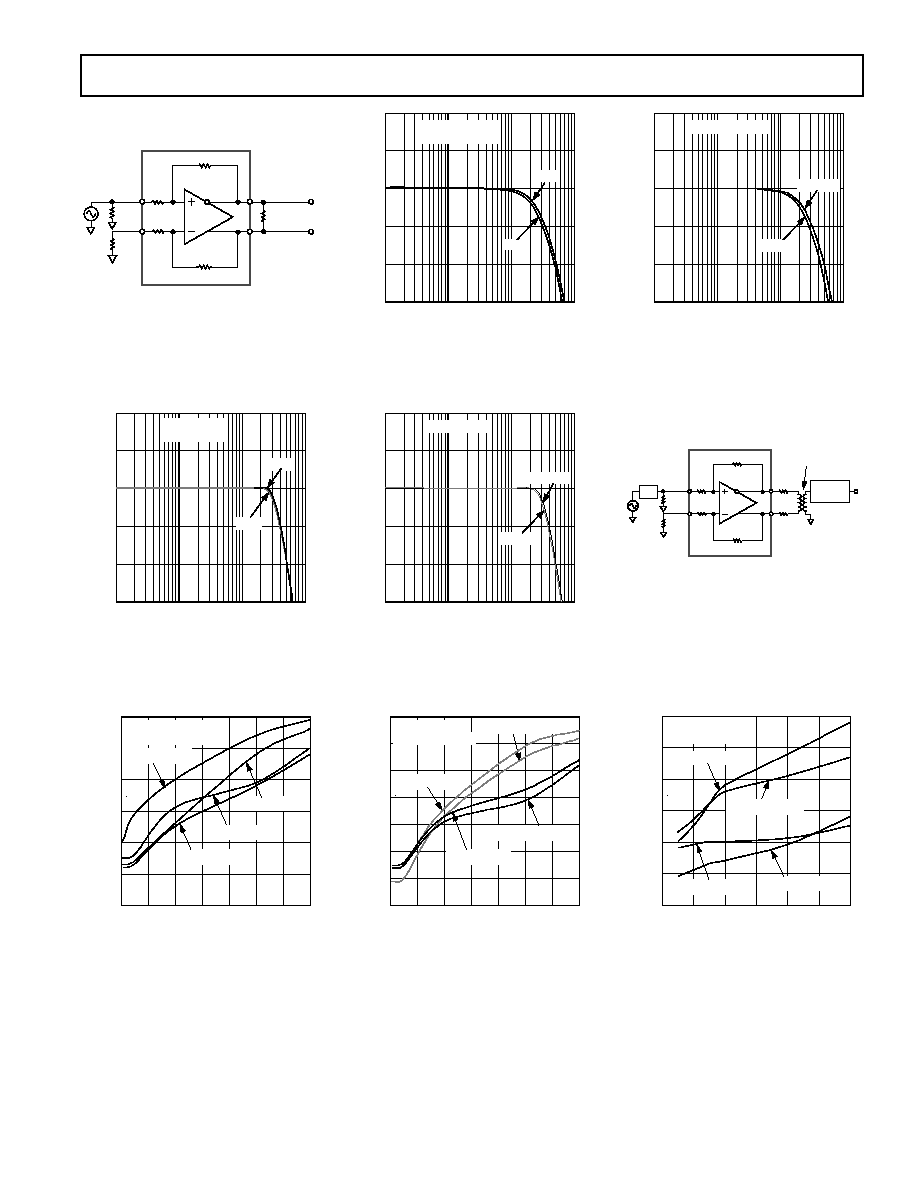
REV. 0
AD8131
5
AD8131
1500
1500
750
750
24.9
49.9
R
L
,dm = 200
Figure 2. Basic Test Circuit
FREQUENCY MHz
GAIN dB
12
3
1
1000
10
100
9
6
3
0
V
OUT
= 2V p-p
V
S
= 5V
SO
SOIC
Figure 5. Large Signal Frequency
Response
FREQUENCY MHz
DISTORTION dBc
50
100
0
70
10
50
60
70
80
90
110
20
30
40
60
R
L
,dm = 800
V
OUT
,dm = 1V p-p
HD3 (V
S
= 3V)
HD2 (V
S
= 3V)
HD3 (V
S
= 5V)
HD2 (V
S
= 5V)
Figure 8. Harmonic Distortion vs.
Frequency
FREQUENCY MHz
GAIN dB
12
3
1
1000
10
100
9
6
3
0
V
OUT
= 200mV p-p
V
S
= 5V
SOIC
SO
Figure 3. Small Signal Frequency
Response
FREQUENCY MHz
GAIN dB
12
3
1
1000
10
100
9
6
3
0
V
OUT
= 2V p-p
V
S
= 5V
V
S
= 5V
Figure 6. Large Signal Frequency
Response
FREQUENCY MHz
DISTORTION dBc
50
100
0
70
10
50
60
70
80
90
110
20
30
40
60
HD2 (V
S
= 5V)
HD3 (V
S
= 5V)
HD2 (V
S
= 5V)
HD3 (V
S
= 5V)
R
L
,dm = 800
V
OUT
,dm = 2V p-p
40
Figure 9. Harmonic Distortion vs.
Frequency
FREQUENCY MHz
GAIN dB
12
3
1
1000
10
100
9
6
3
0
V
OUT
= 200mV p-p
V
S
= 5V
V
S
= 5V
Figure 4. Small Signal Frequency
Response
AD8131
1500
1500
750
750
24.9
49.9
LPF
300
300
HPF
Z
IN
= 50
2:1 TRANSFORMER
Figure 7. Harmonic Distortion Test
Circuit (R
L,dm
= 800
)
DIFFERENTIAL OUTPUT VOLTAGE V p-p
DISTORTION dBc
65
115
0
1
5
75
85
95
105
2
3
4
6
HD3 (F = 20MHz)
55
V
S
=
5V
R
L
,dm = 800
HD2 (F = 20MHz)
HD2 (F = 5MHz)
HD3 (F = 5MHz)
Figure 10. Harmonic Distortion vs.
Differential Output Voltage




